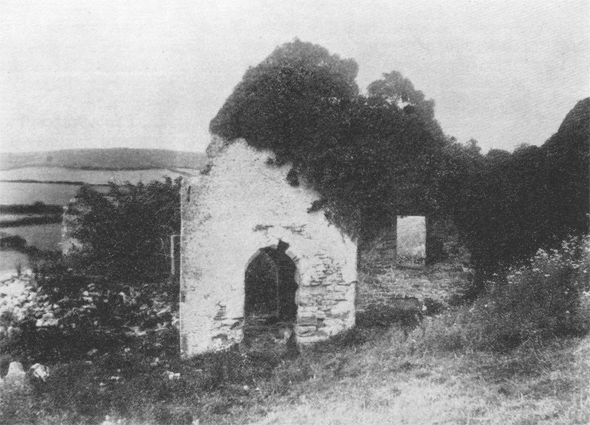
Photo taken in 1909 of the Ruined Chapel at Stanton St. Gabriel.
Helping you discover your Dorset Ancestors
The ruins of an old chapel stand to remind us of the disappeared village of Stanton St. Gabriel. Its origins are shrouded in mystery and confused by legend, but of its passing there is no secret: the cause can be summed up in one word – progress.
The hamlet existed at the end of a narrow lane about a mile west of Chideock in the west of the county. Here it was tucked away in the hills and downs in a valley open to the sea. It sat just a few hundred yards from the great cliff known as Golden Cap rising 618 feet out of the sea. The remains of a farmhouse, a cottage and just the derelict walls and a once impressive south porch are all that remain of the chapel.
There was once a Saxon settlement here and mention of the hamlet can be found in the Domesday Book. Legend would have us believe that centuries ago a newly married couple were escaping in a small boat from a stricken ship that had been damaged in a storm. Praying to the angel Gabriel for their safe deliverance from the treacherous waters the young husband promised to build a chapel to the saint. The story relates how the young wife died in her husband’s arms as their boat landed at the foot of Golden Cap. He was true to his word and built a church here, whether to honour Gabriel or his lost love we will never know.
The economy of the community here would have been based on agriculture. Even as late as 1841 when the first official and national census was taken the population had stood at only 106 people occupying twenty houses and the majority of the men were engaged in agriculture either as farmers or agricultural labourers.
By the time Sir Frederick Treves found his way to Stanton St. Gabriel the church was already in ruins; indeed that was the case in 1841 when a new church was built at Morecombelake, which is on the parish border of Stanton St. Gabriel and Whitchurch Canonicorum. There are reports that suggest the chapel was falling to pieces much earlier and that it had been a constant struggle since the 16th century to keep a decent roof on the building and the church authorities realised the violence of the winter weather meant constant repairs to the building would be too expensive to sanction. By the end of the 18th century it saw only occasional use. Around 1883 some attempts were made to rescue some of the contents: the old rood screen (c.1500) and font were transferred to Morecombelake. In the summer the church band would march over from Whitchurch led by the Parson on horseback. For smugglers it was a convenient place to hide away kegs landed on the beach below.
The census of 1901 confirmed Treves’ observation in his book ‘Highways and Byways in Dorset’ of a place “lost and forgotten centuries ago”. Between 1841 and 1901 the population had halved and the community was doomed to disappear altogether when a new coast road a little to the north cut this hamlet off completely and many people would have moved away to Bridport where there were thriving industries.